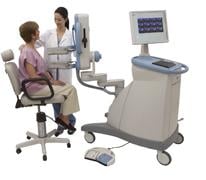
March 3, 2011 – A positron emission mammography (PEM) scanner has been launched at two radiology conferences in Vienna. The Naviscan PEM scanner can reduce unnecessary biopsies by providing superior specificity, and has the ability to differentiate between benign and malignant lesions.
PEM scanners are high-resolution breast PET systems (also referred to as 3-D Molecular Breast Imagers or Tomographic MBI) that can show the location and metabolic phase of a lesion. This information is critical in determining whether a lesion is malignant and influences the course of treatment. PEM scanners are about the size of an ultrasound system.
A poster presentation at the European Congress of Radiology will highlight the role of PEM for assessment of axillary lymph node status in patients with breast cancer. Current morphology-based tools for ALN staging include clinical examination, axillary ultrasound and breast MRI, but none are accurate enough to replace the need for pathologic evaluation of the axillary nodes. In the prospective study, 20 newly diagnosed breast cancer patients underwent mammography, breast and axillary ultrasound, breast MRI and PEM. Suspicious lymph nodes were evaluated and final ALN status was determined via pathology.
The preliminary data show that PEM demonstrates 88 percent sensitivity with a negative predictive value of 91 percent in assessment of ALN status in patients with breast cancer. The data show improved lesion detectability and decrease in background activity.
"Our study provides additional compelling evidence that PEM can play an important role in axillary staging, perhaps with more sensitivity than ultrasound or MRI," said Daniel Appelbaum, M.D., associate professor of radiology from the University of Chicago Medical Center. "Furthermore, these findings, in conjunction with PEM's more extensively documented role in evaluating the breasts themselves as well as whole body PET's excellent whole body staging, paves the way for a complete breast cancer work-up-primary tumor, regional and distant metastases – with one FDG dose."
Naviscan plans to distribute its PEM scanner in Europe during the second quarter of 2011.
For more information: www.naviscan.com


 December 17, 2025
December 17, 2025 









